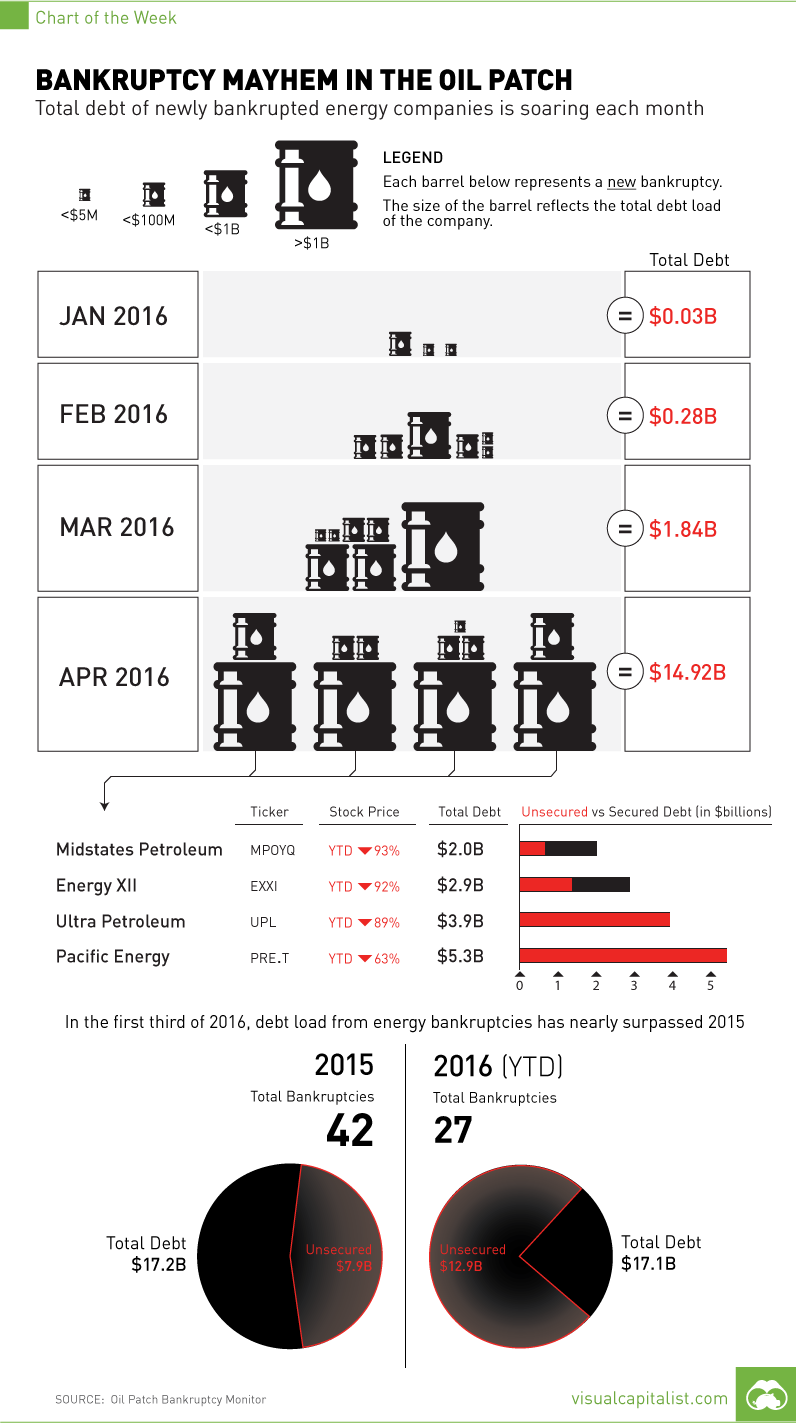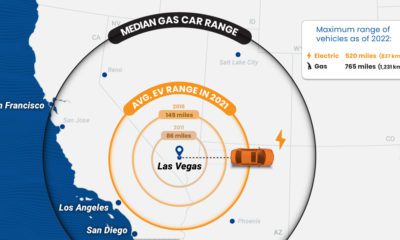Bankruptcy Mayhem in the Oil Patch [Chart]
Total debt of newly bankrupted energy companies is soaring each month
The Chart of the Week is a weekly Visual Capitalist feature on Fridays. Most investors are aware that there is significant carnage in the oil patch. Low energy prices caught overleveraged companies off guard, and it’s forced many of these companies to seek protection from their creditors through bankruptcy. However, the pace of new bankruptcies is accelerating fast, and now bigger companies are being affected. This week’s chart shows that the 11 new bankruptcies in April 2016 carry a substantial debt load of nearly $15 billion – most of which is unsecured. A quick look at the data, which we pulled from Haynes and Boone, LLP, tells the tale: In the first two months of 2016, there were nine bankruptcies. Not one of the companies filing had debts that exceeded $200 million. In March, there were a total of seven new bankruptcies, including Venoco Inc. Venoco is a private company that is heavily oil-weighted with assets located offshore and onshore in Southern California. Venoco’s filing listed that it had $1.28 billion in debts, 71% of which are unsecured. Meanwhile, April was the biggest month for oil patch bankruptcies in the last two years. A total of 11 companies filed, but even more meaningful to investors is that four of the bankruptcies were public companies with debts exceeding $1 billion. Pacific Energy, formerly Pacific Rubiales, used to be the largest operating oil company in South America. Now, however, the company is in the midst of undergoing dramatic restructuring. Common shares have been delisted and the company is also seeking to get extensions on its $5 billion of unsecured debt. Texas-based Ultra Petroleum, which has nearly $4 billion in unsecured debt, has dropped from the NYSE to the OTC as it too seeks protection. The stock’s 52 week high was $17, but it now shares are trading for mere pennies. Two other big companies to go to court were Energy XII and Midstates Petroleum. They each owe roughly $3 billion and $2 billion of total debt, respectively. Energy XII operates 10 of the largest oilfields on the Gulf of Mexico Shelf, while Oklahoma-based Midstates is focused on the application of modern drilling and completion techniques in oil and liquids-rich basins in the onshore U.S. The grand total of debt for all April bankruptcy filers was an astounding $14.9 billion, most of which is unsecured. For reference, the 42 energy companies that filed for bankruptcy in all of 2015 had a combined $17.2 billion in debt. on
#1: High Reliability
Nuclear power plants run 24/7 and are the most reliable source of sustainable energy. Nuclear electricity generation remains steady around the clock throughout the day, week, and year. Meanwhile, daily solar generation peaks in the afternoon when electricity demand is usually lower, and wind generation depends on wind speeds.As the use of variable solar and wind power increases globally, nuclear offers a stable and reliable backbone for a clean electricity grid.
#2: Clean Electricity
Nuclear reactors use fission to generate electricity without any greenhouse gas (GHG) emissions.Consequently, nuclear power is the cleanest energy source on a lifecycle basis, measured in CO2-equivalent emissions per gigawatt-hour (GWh) of electricity produced by a power plant over its lifetime. The lifecycle emissions from a typical nuclear power plant are 273 times lower than coal and 163 times lower than natural gas. Furthermore, nuclear is relatively less resource-intensive, allowing for lower supply chain emissions than wind and solar plants.
#3: Stable Affordability
Although nuclear plants can be expensive to build, they are cost-competitive in the long run. Most nuclear plants have an initial lifetime of around 40 years, after which they can continue operating with approved lifetime extensions. Nuclear plants with lifetime extensions are the cheapest sources of electricity in the United States, and 88 of the country’s 92 reactors have received approvals for 20-year extensions. Additionally, according to the World Nuclear Association, nuclear plants are relatively less susceptible to fuel price volatility than natural gas plants, allowing for stable costs of electricity generation.
#4: Energy Efficiency
Nuclear’s high energy return on investment (EROI) exemplifies its exceptional efficiency. EROI measures how many units of energy are returned for every unit invested in building and running a power plant, over its lifetime. According to a 2018 study by Weissbach et al., nuclear’s EROI is 75 units, making it the most efficient energy source by some distance, with hydropower ranking second at 35 units.
#5: Sustainable Innovation
New, advanced reactor designs are bypassing many of the difficulties faced by traditional nuclear plants, making nuclear power more accessible.
Small Modular Reactors (SMRs) are much smaller than conventional reactors and are modular—meaning that their components can be transported and assembled in different locations. Microreactors are smaller than SMRs and are designed to provide electricity in remote and small market areas. They can also serve as backup power sources during emergencies.
These reactor designs offer several advantages, including lower initial capital costs, portability, and increased scalability.
A Nuclear-Powered Future
Nuclear power is making a remarkable comeback as countries work to achieve climate goals and ultimately, a state of energy utopia. Besides the 423 reactors in operation worldwide, another 56 reactors are under construction, and at least 69 more are planned for construction. Some nations, like Japan, have also reversed their attitudes toward nuclear power, embracing it as a clean and reliable energy source for the future. CanAlaska is a leading exploration company in the Athabasca Basin, the Earth’s richest uranium depository. Click here to learn more now. In part 3 of the Road to Energy Utopia series, we explore the unique properties of uranium, the fuel that powers nuclear reactors.






























